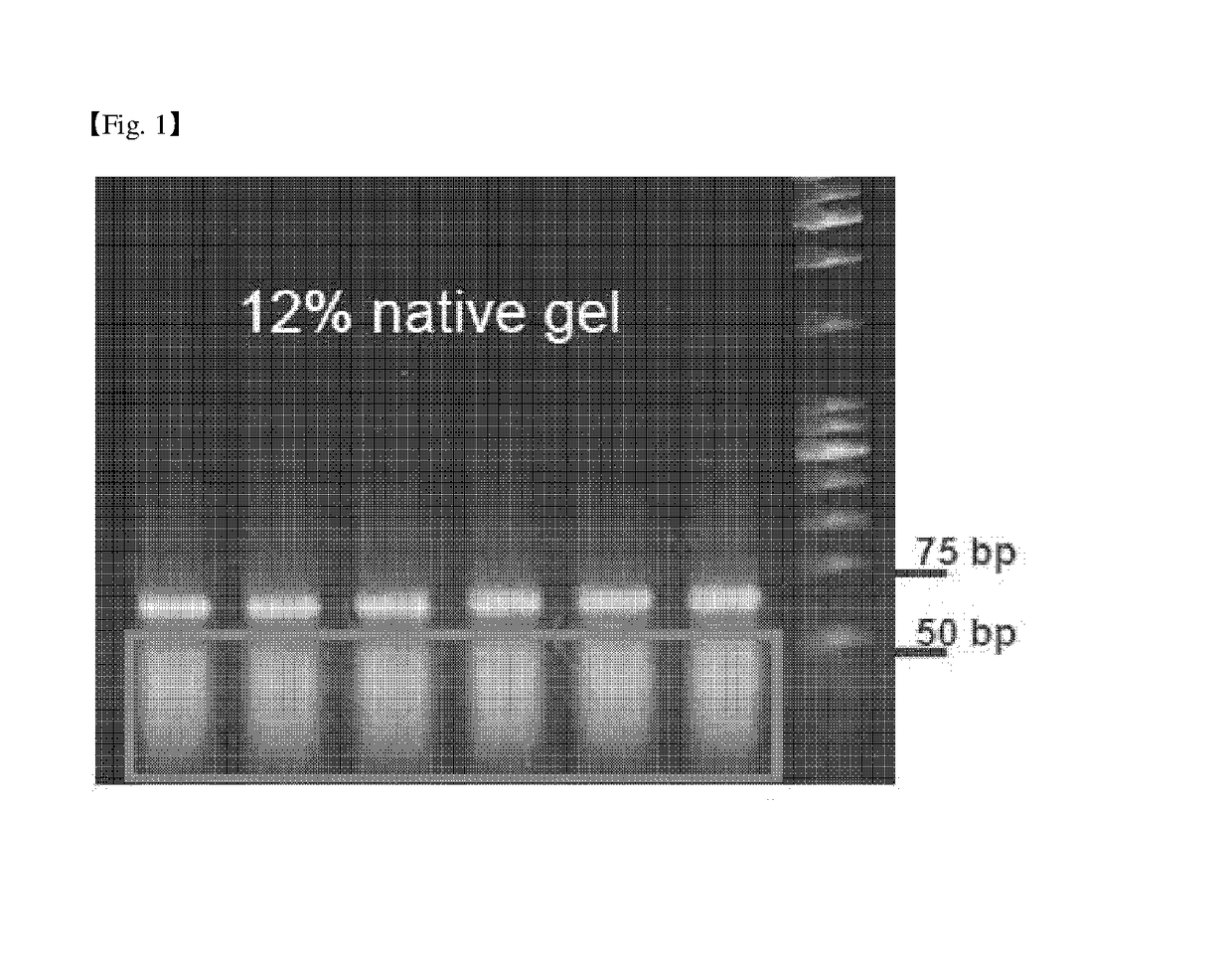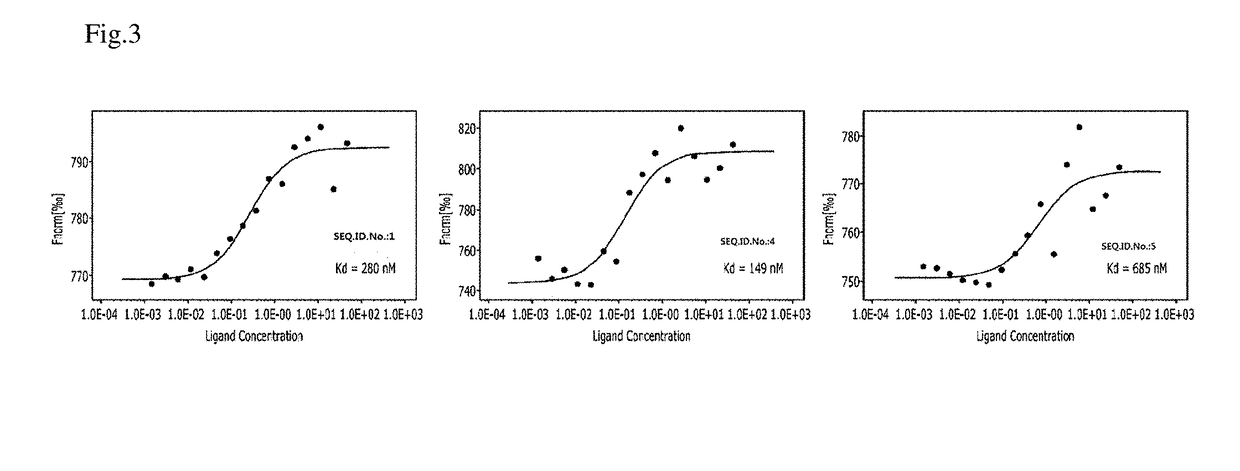Aptamer specifically binding to L-Ascorbic acid and use of the same
a technology of l-ascorbic acid and aptamer, which is applied in the direction of dna/rna fragmentation, biochemistry apparatus and processes, recombinant dna-technology, etc., can solve the problems of reducing the antioxidant function of the skin, reducing the state of vitamin c, and increasing the cost of research and investment. , to achieve the effect of keeping the antioxidant function, reducing the cost of research and investment, and continuous and maximize the antioxidan
- Summary
- Abstract
- Description
- Claims
- Application Information
AI Technical Summary
Benefits of technology
Problems solved by technology
Method used
Image
Examples
example 1
ON OF A SINGLE STRANDED DNA LIBRARY
[0028]A single-stranded DNA library was constructed to screen single-stranded DNA aptamers specifically binding to L-Ascorbic acid using the SELEX method. Single-stranded DNA library sequences were consisted of a total of 60 bases, each containing 15 specific primer sequences at 5′ and 3′ and having 30 random sequences.
[0029]The single stranded DNA library as designed above is as follows.
5′-ATGCGGATCCCGCGC-N30-GCGCGAAGCTTGCGC-3′(single stranded DNA library sequence; SEQ ID NO: 30)
[0030]A single stranded DNA library was amplified by an asymmetric PCR procedure using a single oligonucleotide fragment of the synthesized base sequence of SEQ ID NO: 30 as a template. Primers 1 and 2 were constructed to perform the asymmetric PCR.
[0031]The base sequences of primers 1 and 2 above are as follows:
(Primer 1; SEQ ID. NO: 31)5′-ATGCGGATCCCGCGC-3′(Primer 2; SEQ ID. NO: 32)5′-GCGCAAGCTTCGCGC-3′
[0032]The asymmetric PCR was performed by mixing Primer 1 and Primer ...
example 2
SELECTION OF APTAMERS SPECIFICALLY BINDING TO L-ASCORBIC ACID
[0033]In order to select the single stranded DNA aptamers that specifically bind to L-ascorbic acid to inhibit oxidation, SELEX (rGO-SELEX) technology using graphene was utilized (Lee, A. Y., Ha, N. R., Jung, I. P., Kim, S. H., Kim, A. R., & Yoon, M. Y. (2017). Development of a ssDNA aptamer for detection of residual benzylpenicillin. Analytical biochemistry, 531, 1-7.).
[0034]Hereinafter, the SELEX method using graphene is as follows.
[0035]At first, in order to remove the single-stranded DNA non-specifically binding to graphene and 1.5-ml tube, 200 pmol of single-stranded DNA library and 4 mg / mL of graphene were mixed in a binding buffer (20 mM Tris, pH 8.0), reacted for 30 minutes, and then the supernatant was removed by two centrifugations. The remaining single-stranded DNA and graphene mixtures was treated with ascorbic acid for 30 min to react them, and the single-stranded DNA bound to ascorbic acid was amplified by th...
example 3
THE ANTIOXIDANT EFFECT OF ASCORBIC ACID
[0036]phenylenediamine (OPDA) assay was performed to analyze the antioxidant effect of L-ascorbic acid by an aptamer. The antioxidant effect of ascorbic acid by the aptamer was analyzed by using the principle that DHA, which is an oxidized structure of L-ascorbic acid, binds to OPDA to develop fluorescence (Vislisel, J. M., Schafer, F. Q., & Buettner, G. R. (2007). A simple and sensitive assay for ascorbate using a plate reader. Analytical biochemistry, 365(1), 31-39.).
[0037]The OPDA analysis procedure is as follows.
[0038]Sixteen sequences were synthesized according to the frequency and folding structure of the sequence analyzed by NGS technology in SELEX products. The synthesized single-stranded DNA was heated at 95° C. for 5 minutes and reacted at room temperature for 10 minutes to form a folded structure. Then, 1 μM of single stranded DNA and 5 mM ascorbic acid were mixed and reacted for 30 minutes. Then, hydrogen peroxide (H2O2) was added t...
PUM
| Property | Measurement | Unit |
|---|---|---|
| temperature | aaaaa | aaaaa |
| pH | aaaaa | aaaaa |
| Gibbs free energy | aaaaa | aaaaa |
Abstract
Description
Claims
Application Information
 Login to View More
Login to View More - R&D
- Intellectual Property
- Life Sciences
- Materials
- Tech Scout
- Unparalleled Data Quality
- Higher Quality Content
- 60% Fewer Hallucinations
Browse by: Latest US Patents, China's latest patents, Technical Efficacy Thesaurus, Application Domain, Technology Topic, Popular Technical Reports.
© 2025 PatSnap. All rights reserved.Legal|Privacy policy|Modern Slavery Act Transparency Statement|Sitemap|About US| Contact US: help@patsnap.com



